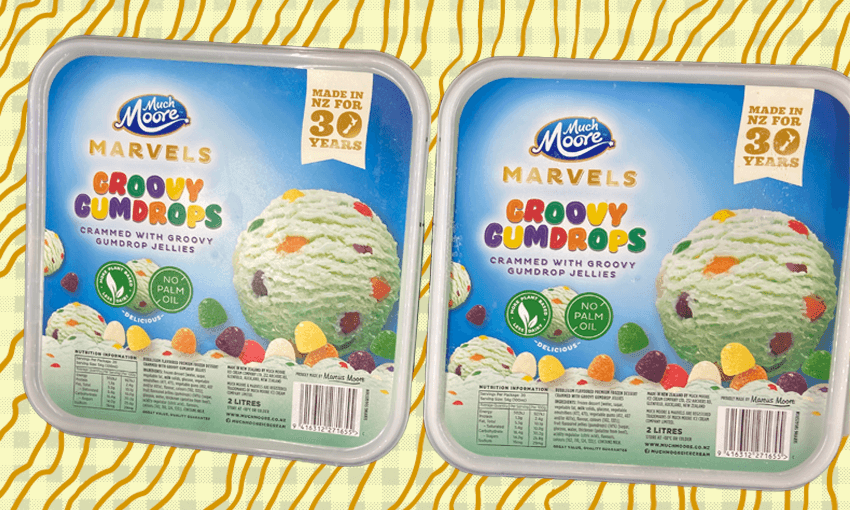Much Moore says the ‘more plant based, less dairy’ label used on some of its products is meant to inform customers. But not everyone is convinced, reports Stewart Sowman-Lund.
A “frozen dessert” by popular budget ice cream brand Much Moore has been criticised by vegan advocates for potentially misleading consumers over its ingredients. But the Ministry for Primary Industries, and the manufacturer itself, disagree.
Much Moore makes a range of ice cream, or “frozen dessert”, products available at major supermarkets nationwide. Among those is its lower cost “Marvels” range, which includes flavours like Groovy Gumdrops and Chocolate Cookies, described on the brand’s website as being “delicious, nutritious and affordable”.
But it’s the labels on some of these products that have vegan advocates concerned. Prominently visible on the front of the tubs is a white leaf in a green bubble surrounded by the text “more plant based” and “less dairy”.
Despite the leaf label, the Marvels products still contain milk products and, in the case of Groovy Gumdrops, “gelatine from beef”, leading vegan advocates to accuse the brand of misleading the public. “We really dislike this labelling. It’s very misleading and is not clear at all,” said Claire Insley, a spokesperson for the New Zealand Vegan Society. “We have been trying to get the [Food Standards Authority] to apply proper labelling laws, however they claim there is no problem and that consumers are not confused.”
When a photo of the same branding was shared to Reddit earlier in this month, others were equally critical. “While the label does say more plant based and less dairy, the green leaf symbol is a visual cue for fully plant based/vegan people,” said one. “I think they should just have something like ‘reduced dairy’ on there.”
Insley from the Vegan Society said the label was “trying to mislead people” into thinking the product was plant based. “It is not 100% plant based and we would like the Food Standards Authority to take these labels seriously,” she said.
Consumer NZ agreed with the Vegan Society that the labelling could lead people to believe the product was vegan-friendly. “Our take is this packaging risks misleading New Zealanders – given the product contains milk, milk solids and gelatine from beef, the word ‘more’ is doing a lot of heavy lifting,” a spokesperson said.
But Much Moore said its labelling was intended to inform consumers, rather than mislead. “The intention of our wording ‘more plant based, less dairy’ and logo is to communicate the product contains more plant based ingredients than dairy ingredients. It is intended to be informative,” the manufacturer said in a statement. “We believe a consumer might be interested in understanding this fact… The comparison we are trying to communicate is the plant vs dairy content.”
But how much less dairy content is in “Groovy Gumdrops” anyway? Enough for it to not actually be called ice cream at all. The Marvels products are instead labelled “frozen dessert” as opposed to ice cream. The Australia and New Zealand Food Standards Code notes that ice cream must contain no less than 100 grams per kilogram of milk fat and at least 168 grams per litre of food solids. The more premium Much Moore Awesome range contains “10% milk fat”, according to the ingredients list, which would meet the requirements to be called ice cream. No such percentage is listed on the “more plant based” budget range of “frozen desserts”.
As a comparison, the ingredients list on a tub of vanilla bean ice cream by premium brand Kāpiti showed 14% milk fat as well as fresh cream (39%) and fresh whole milk (22%).
A comparison of the ingredients list between the Much Moore Marvels “Groovy Gumdrops” and the more expensive Much Moore Awesome “Gumdrops” flavours show both products contain largely the same ingredients, though the cheaper variation has water added and some citric acid – which is technically a plant product. There is no label on the pricier variant touting its plant-based ingredients.
However, the Ministry for Primary Industries agreed with Much Moore’s reasoning, telling The Spinoff that the product labelling was compliant with the Food Standards Code as it did not make claims that the product was vegan or dairy-free. “Gelatine from beef and milk solids are clearly listed as ingredients,” the ministry’s food safety deputy director-general Vincent Arbuckle said.
The use of the leaf symbol and the colour green also weren’t misleading, Arbuckle added. “It is up to the manufacturer to determine what they put on their label, so long as it complies with all relevant legislation,” he said. “A manufacturer must be able to support any claims it makes about a product. In this case, it must be able to demonstrate the quantity of plant-based and dairy ingredients the product contains compared to similar full-dairy products.”
Insley said while she hadn’t been made aware of Much Moore’s label before, “this kind of thing deeply annoys me and the rest of the Vegan Society”. She has urged anyone else concerned with “misleading product labels” to inform the society.
The Commerce Commission wouldn’t comment specifically, but said that businesses must not give people “false or misleading information” or “create a misleading impression about a product”. Any business that did this would be at risk of breaching the Fair Trading Act.



